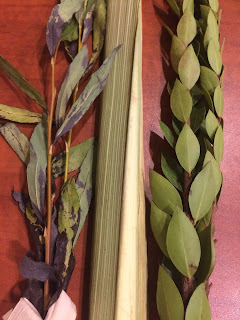Keeping the Willows Alive

For the first two parts of this series on the Four Species, see http://rabbischeinberg.blogspot.com/2017/10/the-lulav-growth-frozen-in-time.html and http://rabbischeinberg.blogspot.com/2014/10/the-fruit-that-remembers-what-botanists.html . Hopefully part 4 on the Myrtles will be ready in time for Sukkot 5779. Sukkot is a holiday of technological challenges, major and minor, that pit a Jew against the forces of nature. Challenge #1: Build a structure that is temporary and flimsy enough that it meets the criteria for a sukkah according to Jewish law, and strong enough to withstand the wind and rain that many Jewish communities can expect at this time of year. Challenge #2: Keep the Lulav’s willow and myrtle branches looking fresh, with vibrant green leaves, when natural processes lead the myrtle leaves to dry out and the willow leaves to turn black and grow mold. Our synagogue distributes care instructions with the Lulav and Etrog sets that we sell. ...
